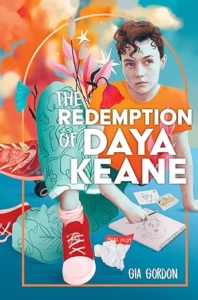The Redemption of Daya Keane
Gia Gordon
Publisher
Published May 28, 2024
Amazon | Bookshop | Goodreads
About The Redemption of Daya Keane
The end of Daya Keane’s junior year in Escondido, Arizona, is anything but expected.
And it starts when her longtime, swoon-worthy crush, Beckett Wild, actually talks to her at a party neither of them should’ve been at.
But as Daya’s best friends, Stella and B’Rad, are quick to point out, smart, cute, artistic Beckett is also the poster girl for the wildly popular youth group at Grace Redeemer, the megachurch Daya’s mom prays at and pushes her daughter to attend.
Amid the concert-worthy light shows, high-energy live band, and pastor preaching to love thy neighbor so long as thy neighbor “gets right with God” first, Daya struggles to find her place in a house of worship that doesn’t seem to create space for someone like her. Then again, she never planned to fall this hard for a girl like Beckett Wild.
Now Daya has to decide how far she’s willing to surrender to Beckett’s world of Grace Redeemer, and who she’s willing to become to be with her.
A fearless and profound tale ideal for readers of Jeff Zentner and Jennifer Dugan, The Redemption of Daya Keane gives an intimate and unforgettable look into a world that demands to be seen.
My Review
This might be the most triggering book that I’ve ever read in terms of its religious representation. I’ll get to that, though.
First, I want to say that this book is one of those debuts that really doesn’t read like a debut. The characterization is so perfect. The banter between characters feels so authentic and had me literally laughing out loud in a few scenes. I love Daya and her two closest friends so much.
In the story, Daya visits a church that reminds me of places I’ve attended myself in the past. The worship service is highly polished and filled with songs that sound identical to those performed by popular artists on the radio. It’s funny because I grew up in that environment, so reading about someone looking in from the outside was a whole new experience for me.
Daya’s critique of the church world rang true. She spots hypocrisy in the way the church has perfected its merchandising and glittery appeal. Her assessment of the kids in the Great Wait club also landed a bullseye. It made me think of a passage from Barking to the Choir by Jesuit priest Gregory Boyle:
“In a recent New Yorker profile of American Baptists, the congregation’s leadership resigned itself to the fact that “secular culture” would always be “hostile” to Christianity. I don’t believe this is true. Our culture is hostile only to the inauthentic living of the gospel. It sniffs out hypocrisy everywhere and knows when Christians aren’t taking seriously what Jesus took seriously.”
That’s how the scenes in this book struck me. It’s not that Daya was necessarily on a deep spiritual quest, though she was desperately trying to understand her mom’s perspective and wanted to give the church a chance for her mom’s sake. But instead of finding life, and life abundant, she found a performative, control-based, rules-oriented organization that devalued her without ever bothering to get to know her.
All that to say that this book struck a deep chord with me, and I have a feeling I’ll return to this story again in the future. If you like young adult books by Jeff Zentner or Adam Sass, definitely check this one out.
Content Notes
Recommended for Ages 14 up.
Profanity/Crude Language Content
Strong profanity used.
Romance/Sexual Content
Kissing. References to sex. One scene includes characters undressing and a brief description of sex.
Spiritual Content
Daya attends church with her mother, religious club meetings, and a dance centered around abstinence.
Violent Content
Several scenes include homophobic statements and beliefs, including reference to conversion therapy and being kicked out of one’s home because of being LGBTQIA+.
One character reveals that their parents died by murder-suicide. A man drunkenly rages in a nearby house.
Drug Content
References to teen drinking and smoking pot. In one scene, Daya smokes with two other teens.
Note: This post contains affiliate links, which do not cost you anything to use but help support this blog. I received a free copy of this book in exchange for my honest review. All opinions are my own.
